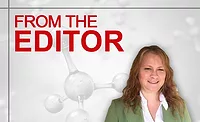Industry Roundtable: Key Players in the Adhesive and Sealant Industry Share their Insights
How is the industry dealing with supply chain volatility? What end-use markets are offering the most opportunities? Adhesives and sealants leaders share their thoughts on these issues and more.
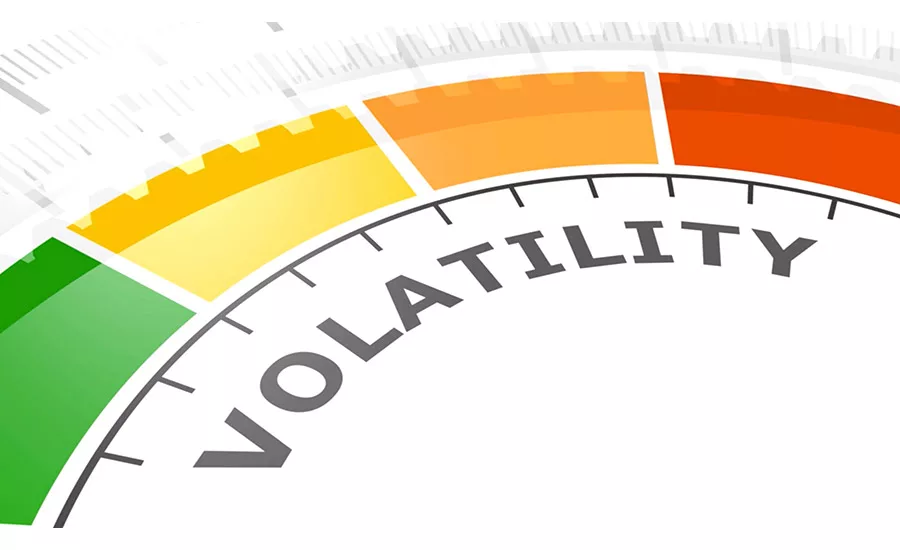
I recently reached out to key industry players—ranging from raw materials suppliers to manufacturers of finished adhesives and sealants—to get their takes on factors ranging from supply chain volatility and sustainability initiatives to research and development efforts.
How are supply chain issues impacting your business?

Ted Clark, Executive Vice President and Chief Operating Officer, H.B. Fuller: Supply chain impacts from the pandemic compounded by Winter Storm Uri on the Gulf Coast and shipment delays from the Suez Canal incident have created tightening, which is impacting global supply. Supply has become particularly tight for commodity materials, which make up a smaller portion of our portfolio. As the year progresses, this also will have an impact on the supply and pricing of specialty materials, which make up the bulk of our purchases.
Most suppliers have made good progress in recovering from Uri. However, the rate of recovery going forward will mostly depend on the output rates of the impacted assets and the time it takes for supply chains and inventory levels to fully recover. We expect that raw material costs going forward will increase at a faster rate than originally anticipated due to increased demand, reduced inventories, and supply constraints.
A key focus for us at H.B. Fuller, regardless of market conditions, is to ensure supply for our customers. Due to several proactive actions that we have taken over the past several years, we are fortunate to be able to get raw materials even when supply is tight. Our team has done a remarkable job of supporting customers through supply shortages by working closely to manage inventories and available materials. Our contracted positions with our suppliers, backward integration of key polymers, and global breadth have helped us manage the supply crisis thus far.
The breadth of our adhesive chemistry and the diversity of our raw materials has meant that no single material has had a large impact and has enabled us to help customers find alternatives when short supply exists. The near-term disruptions we are navigating are considerable, but they are temporary, and supply is expected to normalize to a more balanced level in the coming months.

Eric Dumain, Global Marketing Director, Coating Resins, Arkema: Winter Storm Uri brought into focus how fragile industry supply chains can be. North America was already experiencing a demand rebound from the pandemic impact, creating tight inventories within the value chain. Resilience through multiple sourcing options and backup supply sites has helped mitigate disruptions, while not entirely eliminating them.
Transportation of goods was already a problem faced in the industry prior to 2020 and was only further exacerbated by COVID-19. Forecast accuracy and subsequent supply chain, inventory, and logistics are increasingly challenging to manage, requiring much closer coordination between suppliers and their customers.
Luckily, we were expecting raw material volatility, supply chain, and transportation issues, as well as volatile market conditions due to COVID-19, to continue throughout 2021. We are working closely with all of our customers to implement the best possible solutions.

Krista Grayson, Director of Sales, Mo-Sci Corp.: Due to COVID, some of our vendors have had shifts in priorities to aid in supplying COVID-related parts and products. This has caused some sourcing concerns on our end because the shift in priority makes it more difficult to source the materials that we require.
We have also seen logistical issues with our international customers dealing with border closures and rerouting deliveries. This becomes especially critical when the shipments have a shelf life or time-sensitive handling conditions. Additionally, customers that work off of JIT (just in time) inventories have struggled the most and made requests to advance shipments to help mitigate the impact on their production schedules. This has forced us to increase short-term production to meet the increased product demands that likely will not be sustained long term.
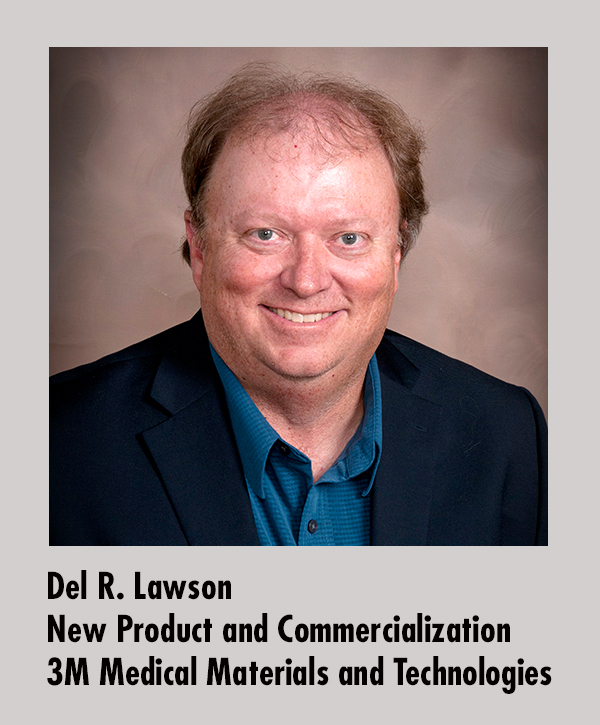
Del R. Lawson, New Product and Commercialization, 3M Medical Materials and Technologies: We are managing multiple supply chain challenges from a variety of factors. Products used in wearables, patient auscultation, and COVID diagnostics are in high demand. Climatic and shipping interruptions have been variable in some instances.
Each challenge requires different skills and focus, from trying to get more out of existing equipment and supplier relationships to managing inventory and allocating limited resources into the most urgent applications. While we have been handling these challenges well, it often feels like we need to apply a lot of attention and focus to avoid missing a critical detail.
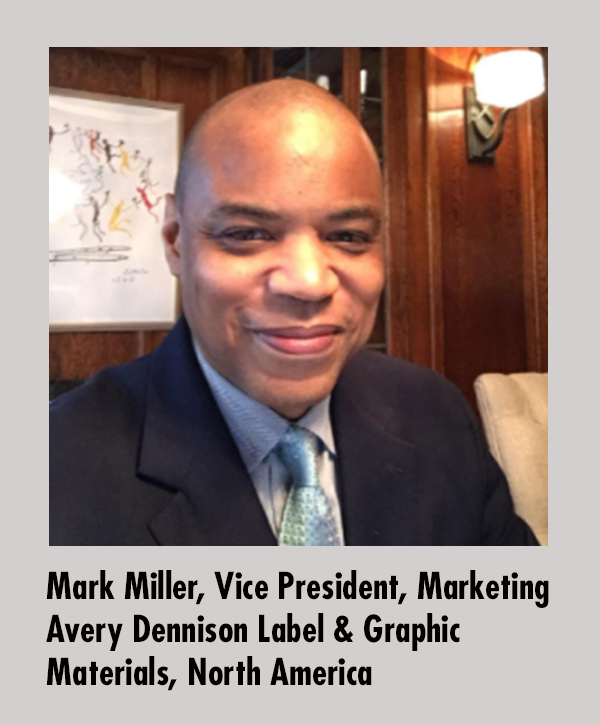
Mark Miller, Vice President, Marketing, Avery Dennison Label & Graphic Materials, North America: Supply chain issues are affecting the entire industry and have been since the beginning of 2021. The system was already under stress from increased volumes throughout 2020. At the beginning of 2021, weather caused even more pressure on the system, and everyone began to see raw materials supply tighten up as freight, transportation, and logistics became issues on top of that.
Since Q1, transportation and freight have eased up a bit, but we’re still working through raw materials supply issues, as is the rest of the industry. In order to mitigate impact on customers, we are adding shifts in our production, with some of our facilities moving from five- to seven-day operations and adding capacity. We are optimistic that by the end of Q2, the industry will see some relief from raw material supply issues.
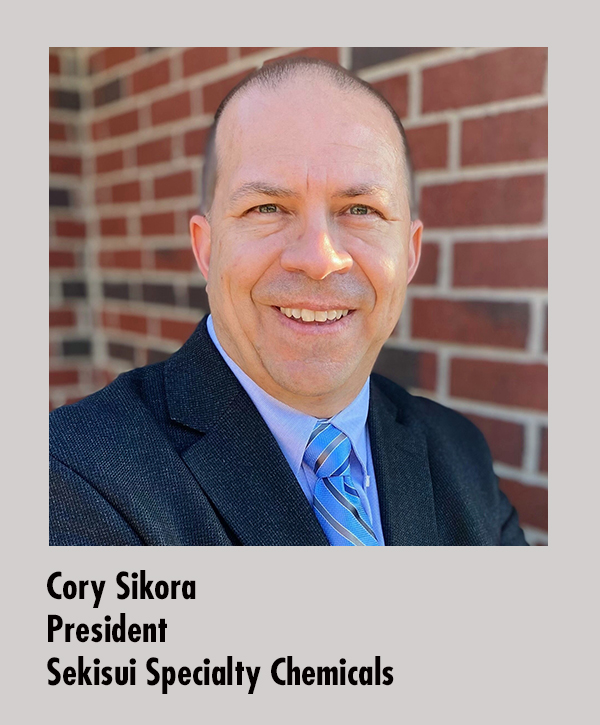
Cory Sikora, President, Sekisui Specialty Chemicals: 2020 and 2021 have certainly seen some incredible volatility and corresponding supply chain challenges in meeting our customers’ needs around the world. With the start of the COVID-19 pandemic and early lockdowns, we saw customers dramatically reduce their demand; that was quickly followed by a significant rebound as economies opened up again and customers tried to restock their inventories and supply chain. The 2021 Winter Storm Event in the U.S. also created significant additional disruption at a time when many companies were still trying to catch up.
Short term, we are working closely with our customers to align as best as possible our supply with their needs as we manage through the aftermath of the storm’s impact. Longer term, we are working with customers to increase the robustness of our supply chain through use of digital transformation tools. With new blockchain technology, we see the potential to enhance speed of information exchange, which translates to better visibility in forecasting and subsequently the ability to plan around supply timing.
What role is digitalization playing in your business?
Clark: Advances in technology have certainly created opportunities for specialty materials companies like ours. From the use of robotic process automation in our back-office activities to advanced modeling in the design of new products to automation on our production lines, we are taking advantage of the latest technologies.
Two areas where we are seeing great potential are in digital marketing and the use of wearable technologies to assist our customers amidst the pandemic and into the future. In areas where travel has been halted or discouraged, we are not able to visit customers to provide technical assistance or to assist in the implementation of new products as we once were. We have overcome this with the use of virtual vision technology.
Through partnerships with wearables producers, we can provide for highly secure transmission of real-time images and videos, keeping our customers up and running and introducing new products without delay. Regardless of visitor and travel restrictions, our customers still need quick access to technical help. In addition to the use of virtual vision for selected customers and opportunities, we also are using virtual and remote technical service offerings, including on-demand customer support via phone, email, WhatsApp, and FaceTime.
Looking ahead in 2021 and beyond, we plan to continue to leverage, optimize, and expand the technology we used throughout the pandemic, as we see it as key to our future of work. In addition, we are investing in implementing intelligent automation tools ranging from simple workflows to robotics to machine learning and artificial intelligence to help streamline many of our manual business tasks. By leveraging intelligent automation, we will be able to shift our employees’ focus toward higher value tasks, achieve faster process speeds, reduce error rates, reduce cost, and improve efficiency.
Dumain: The digital revolution is here, and it isn’t going anywhere. 2020, and the early months of 2021, have pushed virtually everyone in the industry to rethink how they do business. At Arkema, we adapted quickly through tools such as virtual meetings, tradeshows, and training webinars, the first of which we conducted for customers less than two weeks after the travel restrictions took hold last year.
Additionally, we have adapted to both our own and our customers’ new work-from-home lifestyles. We’ve had to develop more creative ways to stay in touch and do business, many of which we will continue for years to come. Digital technology is also assisting global specialty suppliers like Arkema Coating Resins to expand past geographical boundaries for sustainability efforts in terms of growth and innovation.
Grayson: We have seen increased pressures from our customers to have validated software and more stringent digital securities. In order to comply, we are working to update our systems, software, and policies to address these growing concerns.
Lawson: Digitization is an essential part of our strategy and plays a role in many areas of our business. For example, our stethoscope business leans on digitization as we work to launch a series of new products via a strategic partnership that brings the best sound quality, amplification, noise cancellations, software, and decision support AI algorithms to patient assessment.
We continue to develop and refine our technologies to offer faster and more accurate measurements that support patient and regulatory requirements. In our MedTech business, we partner to design and launch new capabilities to assess patient health using sensors, software, and systems for on-body devices. In addition, we offer an array of technologies to support diagnostic systems that are highly relevant for applications ranging from diabetes assessment and management to COVID-19 diagnostics and beyond.
Miller: Digitalization is a major area of growth and opportunity for us in our operations, as well as our commercial functions, such as marketing, sales, and customer service. Over the last 18 months, we have implemented a new ERP system, ecommerce portal, and online claims submission tool. Digital technology and digital enablement will only grow over the next year and years to come. We plan to implement additional self-service digital customer tools over the coming year.

Ian Moore, Ph.D., Vice President Silicones, Wacker Chemical Corp.: Naturally, with the pandemic, we’ve been relying heavily on virtual meetings to connect with our customers. Before the pandemic, the hands-on events offered through our WACKER Academy always allowed our technical teams to provide in-person, customized experiences and training for our customers. The Academy is now reaching customers virtually, and not only is meeting this need, we’ve seen a 32% increase in attendees during the pandemic year compared to the year prior.
Sikora: We see digitalization playing an increasingly important role in our business. Today, we run our facilities using state-of-the-art control systems designed to maximize safety while helping to boost productivity. These elements have been in place and in use for some time.
Where we see the opportunity for expanded digitalization is in enhancing our ties with customers and translating to improved supply chain robustness. Our supply chain starts with our customers’ forecasts, and by moving to improve the timeliness and visibility of that information, we can more quickly adapt our interface with our suppliers, adapt our production planning, and improve our supply chain performance overall. Ultimately, this leads to better on-time performance in meeting customer requirements, wherever they are in our global network.
Finally, digitalization will continue to play an increasingly important role in our interpersonal interactions. Our business adapted from our pre-COVID norm of having our teams in our offices and facilities, interacting in person or by phone, to one of working remotely.
To facilitate this and maintain effective communication, both internally and externally, we had to quickly ramp up our use of internet-based collaboration tools, such as Microsoft Teams or Zoom. These tools have been instrumental in helping to keep up the level of interaction needed to manage our business and meet our customers’ requirements effectively. Looking ahead, we anticipate we will continue to use them extensively, both for the benefits of face-to-face interaction (if not in person) as well as the cost savings associated with some reduced travel.
What markets/applications are providing the most sales growth opportunities for your company?
Clark: Overall, shifts in product demand have occurred over the past year due to the pandemic, which impacted our sales. Over the past year, we have seen an uptick in consumable goods and the packaging used to protect them. For example, we saw an interesting spike in in-home toilet paper products that will eventually reverse as businesses, restaurants, and entertainment venues go back to full capacity, as industrial toilet paper uses less adhesive than in-home products.
Early in the pandemic, we also saw a slowdown or some erratic purchasing patterns in the durable goods markets such as automotive, aerospace, and electronics. Many of those industries are picking up again on top of strong demand for consumable products.
Something interesting that we saw, and worth noting, was that alternative modes of transportation surfaced, such as the recreational vehicle market, while other modes of transportation like passenger air travel declined in 2020. We are already seeing signs that air travel will rebound and, at the same time, expect the RV market to continue to show strong growth through 2025.
The electronics and new energy segments continue to have an exceptional growth trajectory, as they did prior to the pandemic. We expect growth in these areas as well as across most of our EA markets to drive double-digit full-year growth across this segment.
Dumain: The state of the adhesives and sealants industry is robust and continues to provide increasing value in applications such as packaging, building and construction, automotive, industrial, medical, and many others. In 2020, we saw a surge in demand for pressure-sensitive adhesives used in social distancing and other safety-focused labeling initiatives. These include both temporary door and floor labels associated with directing foot traffic or providing instruction related to the pandemic. Arkema Coating Resins has been working with multiple label manufacturers to provide the solutions they need for these applications.
We also see robust demand for building and construction products, now that the housing segment is opening up again. Because of the shortage of residential housing resulting from underinvestment since the 2008 financial crisis, the industry finds itself in a new period of growth.
Grayson: As one of the remaining few small specialty glass shops, we are seeing an increase in service-related inquiries. Customers are asking for add-on services such as spray-drying, milling, coatings, packaging, and even consulting services. This potentially opens up opportunities for us to expand our offerings and provide multiple services to our existing customers and make us more attractive to other customers looking for one-stop solutions.
Lawson: The wearables market continues to grow rapidly, especially in the area of diabetes care with products such as continuous glucose monitors (CGMs). The incidence of diabetes continues to grow, and managing glucose levels to minimize poor outcomes may be treated with CGM devices worn for extended periods.
Diagnostics applications are growing even faster as a direct result of the global pandemic. Our components have played an important part with several manufacturers as diagnostic testing plays an instrumental role in slowing the spread of the pandemic. This market growth is still evolving with the impact of vaccination but does not predict a return to pre-pandemic levels due to various factors.
Miller: COVID-19 provided the industry with growth in a few key areas. Ecommerce labels, labels for health and personal care items, pharmaceutical labels, and tamper-evident/security labels are a few examples of where we saw growth. The growth largely followed consumer buying trends during the pandemic, and we continue to see strong performance in those areas in 2021. As we move forward, we know that sustainable label materials and label materials that enable a circular economy or enable recycling will be critical to growth.
Moore: All the industries and market segments we serve have seen an uptake recently due to businesses reopening and customers refilling supply chains. Specifically, we’re seeing textiles roaring back and a significant turnaround in the automotive industry. The demand we’re seeing in automotive appears to be disconnected from the actual auto sales with end-user products, so this indicates to us businesses are rebuilding their supply chains—and it’s a long supply line to refill. The oil and gas industry is also experiencing small increases.
Sikora: Automotive, construction, and paper are three critically important markets for our business. Over the last year, we’ve seen these markets impacted to varying degrees by the COVID-19 pandemic, such as with automotive significantly slowed during the early stages of the pandemic but picking up considerably in the second half of 2020, to more moderate demand reductions in construction, emulsions, and adhesives, and even in some cases to higher demand, such as for paper tissue manufacturing. In the paper industry, demand for commodity printing paper slowed, while areas like tissue, packaging, and food servicing increased to support the rapid shift to at-home working and shopping.
We and our customers are wrestling with how these demands might evolve in the future, and we think it will depend heavily on how life changes post-COVID. For example, how do automotive demands change if more people work from home longer term and thus commute less, or will companies reduce office space, leading to a longer term dip in commercial office construction? How will this shift affect demand for at-home tissue vs. away from home (office and retail) tissue? So while we don’t yet have a good feel for what the future will hold, our thinking is around how to build more flexibility in our business and be able to adapt readily to changing demand patterns across different segments as they come.
What are some of your company’s sustainability-related initiatives?
Clark: Our commitment to sustainability drives us to look for ways to minimize our company’s footprint through sustainable business practices and to enable our customers to achieve their sustainability goals. H.B. Fuller supports the United Nations’ Agenda for Sustainable Development and aligns its Environmental, Social and Governance activities to the U.N. Sustainable Development Goals (SDGs). We also participate in supply chain reporting through CDP and EcoVadis, and we recently conducted a materiality assessment in order to begin using the Global Reporting Initiative (GRI) framework.
Internally, we are focused on minimizing the impact of our operations. We monitor our environmental footprint and continually innovate for improved sustainability in our products and manufacturing practices. Since establishing our sustainability goals, which include reductions in energy intensity, greenhouse gas emissions, waste creation, and water usage, we have driven a downward trend across each of these metrics.
We also collaborate with customers to create adhesive solutions that allow them to meet their sustainability goals. Our products help customers save energy, reduce waste, and enable recycling and reuse. This is where we believe we can have the most impact.
Often, we make our sustainability impact by extending the “mileage” of our adhesives, helping our customers use less adhesives, which manifests in both lower raw material consumption and lower energy cost in transportation. An even bigger impact comes when we can enable our customers in industries like transportation to successfully bond low surface energy substrates together, resulting in car, truck, RV, railcar, and boat lightweighting, which leads to improved fuel efficiency.
H.B. Fuller is making an impact on sustainability by helping our customers move away from traditional materials and into more sustainable main components. One example of that is paper straws. We have been able to formulate greener adhesives that deliver on food compliance regulations and survive direct liquid contact. The paper (vs. plastic) provides the basic structure, and the adhesive ensures the straw’s form is maintained both through processing and use. The adhesive is designed to break down and decompose in a landfill or industrial composting facility.
We also are working with manufacturers to replace or reduce packaging such as plastic stretch wrap or cardboard trays. Our team has developed specific solutions for the adhesion of liquid cartons, bottles, and cans in multi-pack formation with small glue dots. Where cardboard handles are still desired, we have a sustainable reinforcing tape solution to allow for minimal cardboard usage. And, we are introducing foamable adhesives to the woodworking market. Foaming adhesives result in less adhesive usage, resulting in fewer raw materials consumed and lower transportation costs for adhesives.
Lastly, when it comes to bio-renewable or waste feedstock-derived adhesives, H.B. Fuller has found that adhesives with up to 50% bio content are currently the optimal solution for disposable diaper manufacturing. These hot-melt adhesives possess the desired mechanical and chemical properties across a wide range of substrates and can be applied using the same equipment used with traditional hot-melt adhesives.
Dumain: Sustainability efforts will be ongoing, and companies that excel in this will have a competitive advantage—both this year and beyond. The most important driver remains reducing the carbon footprint from cradle to grave for adhesives and sealants. Large end users, corporations, and specifications are driving the industry to technologies that will help increase renewable content, reduce emissions, and also energy costs during the construction and operational use of buildings, other infrastructure, and automobiles, as well as other consumer and industrial products. In our own facilities, we have undertaken many initiatives to reduce our water and energy consumption.
The switch from solvent-based to water-based products continues. There is an increased focus also on higher performance water-based products that are more hydrophobic, more durable and help extend life cycles of the materials in the applications that they are used.
One example is a high-solids, tackified acrylic, high-performance pressure-sensitive adhesive (PSA) Arkema introduced last year for marine applications that has been formulated to provide excellent peel and tack adhesion in extreme corrosive conditions. Another example is a high-performance emulsion for latex-based sealant applications that is plasticizer free and provides enhanced mold and mildew resistance.
Arkema is also investing in high-performance solvent-based PSA technology platforms that will provide PSA formulators that already coat solvent-based PSAs for higher performance tape and label applications that ultimately are used for sustainability initiatives such as weatherproofing and lightweighting.
Lawson: 3M has a range of sustainability goals segmented into three key areas: circular, climate, and community. Our circular goals focus on developing design solutions that achieve more with less material. Our climate goals aim to decarbonize industry, accelerate global solutions and improve our environmental impact. Lastly, our community goals create a more positive world through science, inspiring others to join us.
By 2025, we have established many measurable goals we would like to achieve. For example, one of our circular goals is to develop more sustainable materials and products for our customers. We also aim to increase renewable energy use to new heights in support of our climate. Continuous expansion of our diverse talent pipeline in management to support our community is another top priority, among other goals.
Miller: We do have a sustainability team, both here in North America and globally. However, we also feel that it’s every employees’ responsibility to think with a sustainability mindset when it comes to innovation; it’s not just a marketing and sales activity. Sustainability is woven into the fabric of what we do and make, as well as how we do it.
A few of our key sustainability initiatives are: launching our portfolio of sustainable products and solutions, expanding our liner recycling pilot program with Road Runner Recycling to more customers, continuing our involvement in CELAB (the industry consortium for circular economy for labels), continuing to develop and launch products that enable recycling (e.g., sustainable wine materials, compostable facestocks and adhesives, and rPET liners that are constructed from recycled content).
Moore: Regionally and globally, sustainability is a core value and major focus for Wacker. Globally we launched the SustainaBalance® program, aiming to achieve carbon neutrality by 2050 by using resources responsibly, avoiding waste, and minimizing our footprint. This aligns with our commitment to the Sustainable Development Goals created by the United Nations. We use this as a framework in our company’s decision-making.
We continue to create products from renewable raw materials. Most recently, we launched an eco personal care brand globally, and in Europe we launched our eco silicone sealant brand. Both products are silicones-certified, made from bio-based methanol.
Another project we’re working on globally is RHYME (Renewable HYdrogen and MEthanol) to decarbonize our own production. This program looks at producing renewable methanol by combining CO2 production waste with green hydrogen (made from water electrolysis). We’re aiming at reducing fossil raw material and fuel in our chemical processes and products so that we narrow our carbon footprint even further.
Sikora: Sekisui has a strong focus on sustainability, driven by our company’s vision of “Innovation for the Earth.” We believe our technologies can help create products that enhance sustainability and help make life better for everyone around the world. Our R&D and product innovation efforts are made with sustainability in mind and where we make our investments to support product development, we aim to do it in areas that ultimately support this goal.
Beyond our products and services, Sekisui is committed to increase sourcing of renewable energy for our manufacturing operations and to continuing to look for ways to reduce our overall carbon footprint. Our track record on sustainability is something that we’re very proud of and we feel has been recognized with Sekisui being named a Global Top 100 Sustainable Company for four years in a row.
Is your company planning updates to production processes in the next year?
Clark: Yes, we have a number of manufacturing operations and supply chain projects in process, which are expected to drive $20 million to $30 million in annual manufacturing cost savings by the end of 2022, with approximately half of these savings to be realized in 2021. One of the efforts we have underway is the implementation of our H.B. Fuller Way initiative for operations and supply chain. The H.B. Fuller Way is designed to establish a well-defined, common language set of metrics and improvement tools that apply to each of our businesses and factories, along with operations and supply chain processes that effectively meet the needs of our customers. We want to maintain the level of flexibility and agility that is required by customers in all our different market segments while improving our business through cross learning.
Dumain: Planning for continued growth is a focus for us. We are constantly looking for ways to debottleneck our processes to free up capacity.
Grayson: We are continuously looking for ways to improve our production capabilities. We will most likely look at either custom building equipment in house or purchasing new equipment.
Lawson: Improving productivity and quality are always priorities, supported by our journey of over 20 years using Lean Six Sigma best practices. We focus on reducing cost, improving quality, adding automation, and refining test methods to develop the best product possible and reduce waste throughout the process.
Balancing service levels and inventory is a constant tug of war as we work to provide timely products while avoiding warehouses filled with unused materials. Our manufacturing and operations teams work diligently to optimize these processes continuously.
Miller: We operate on a continuous improvement mindset, so we’re always looking at ways to operate more efficiently or to do things better. We stay focused on things that impact customer experience or service. In 2020, we announced the expansion of our facility in Greenfield, Ind., and the addition of several coating assets to that location. We’re in the process of scaling up the new assets, with additional capabilities planned for the future.
Sikora: We continue to make investments and improvements to our processes on an ongoing basis using the Japanese principle of Kaizen, which is the business philosophy of continuous improvement. At all of our sites, our teams have done outstanding work on applying Kaizen to help improve our product quality, manufacturing efficiency, and plant safety. We even share our Kaizen success stories with other Sekisui businesses on a regional basis in an annual Kaizen Competition. This event not only provides an excellent opportunity to share best practices among different Sekisui businesses, but it is also a great way and forum for us to build connection with our peers across the company.
Looking ahead, we are planning some specific investments that will expand our capability to offer novel copolymer technologies to our customer base as well as continue our efforts to improve our safety, quality, and productivity. These efforts are never-ending, and we expect to continue to use our Kaizen process, coupled with strategic capital investments, to help continue to make important improvements across all of our critical functions.
Have your company’s R&D efforts increased or decreased over the past year?
Clark: Innovation is key to our success. Our ability to continue to innovate with customers and get new products qualified is the lifeblood of our organization. Our teams are continually looking to provide better, more affordable products that answer today’s toughest consumer demands.
Our R&D efforts increased and evolved over this past year as our customers needed our adhesives expertise more than ever. Many of our customers relied on H.B. Fuller to help them pivot amidst the pandemic as they shifted from, for instance, making textile car seats to medical gowns per a FEMA order. We helped countless customers shift gears and start producing things like face shields, face masks, and sanitizing wipes. Given the high demand for these types of protective products, we have leaned on our portfolio of reactive hot-melt technologies, which have a much more rapid cure vs. the water-based adhesives traditionally used.
An uptick due to the pandemic’s impact on the world has led to innovations in disposable hygiene products, flexible packaging, and engineering adhesives markets, for example. And, as the new construction and remodeling markets continue to boom, we have introduced various products that make work easier and faster for contractors or do-it-yourselfers, such as a rapid pole setting product and a range of new flooring installation products. Additionally, a new product we developed for the insulating glass market is a system by which the separation, sealing, and moisture adsorbing elements of glass production can be done in one step, creating a sealed glass unit that is both durable and energy efficient.
We expect to see more innovation in the year ahead, particularly as we work with customers in our Hygiene, Health, and Consumable Adhesives businesses to develop innovative applications and ensure supply to meet high demand for their products as well as in the highly specified applications within our Engineering Adhesives businesses.
Dumain: At Arkema, we worked hard to maintain the R&D and product testing levels that our customers have grown to count on. While the pandemic kept many homebound or limited travel, our labs and test fence facility remained active, exploring new applications and developing new products throughout the year. In 2021, we are introducing multiple new products across all of the market segments we serve.
Lawson: Our company and most others were faced with R&D challenges due to work-from-home mandates for employee safety. Still, we did not see a significant fall-off in new product launches. I am very proud of our teams’ flexibility to accomplish significant milestones and still launch key products amid pandemic turbulence. When the time was appropriate, we worked closely with our safety teams to manage the safe return to work for essential employees.
As more vaccinations occur across the country, I expect we will see researchers, engineers, developers, and clinicians travel more. Many of these roles are eager for the ability to be in laboratories to research, develop products, test, and so on when needed. Given that so many of us had to learn a new way to work, I expect we will be operating in a hybrid mode for the foreseeable future.
Miller: When we think about innovation, we look to the future but are firmly rooted in the present. If anything, we see the market continuing to demand innovative solutions from us. The current economic environment has certainly presented its fair share of challenges. We know this will pass in due time and that our customers will still want and need innovative products. For us, our commitment to innovation has not slowed during this time of uncertainty.
Moore: Despite the pandemic reducing some market demand, we continue to add resources to R&D in North America as a part of our strategic plan. The pandemic did not slow down our investments in innovation; in fact, we expect to double our R&D efforts in the region over the next 3-5 years. Our R&D team will continue to focus on all the market segments we serve.
In 2020, we announced plans to build our new Regional Headquarters and Innovation Center in Ann Arbor, Mich., which will open early in 2022. This state-of-the-art facility will provide modern and updated labs and resources for our R&D team. The facility is expandable for the increased R&D and application development activities we are planning for existing and new markets. The facility also offers collaboration areas, bringing the R&D and application teams together in one location. Investing, designing, and building the new Innovation Center during the pandemic is yet another commitment to the region and this country.
To learn more about these companies and their activities, visit www.3m.com, www.arkema.com, https://label.averydennison.com, www.hbfuller.com, www.mo-sci.com, www.sekisui-sc.com, and www.wacker.com.
Looking for a reprint of this article?
From high-res PDFs to custom plaques, order your copy today!




